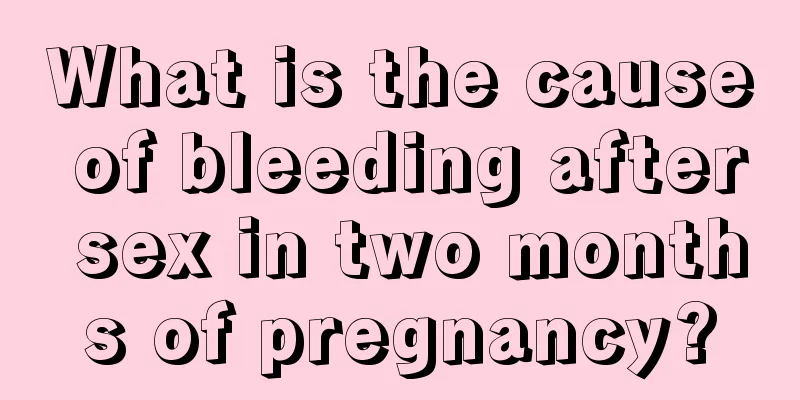Why menstrual disorders

|
Menstrual disorders are becoming more and more common, and to a certain extent, they can reflect the health problems of female friends. The causes of menstrual disorders include abnormal emotions, cold stimulation, dieting, smoking and drinking, etc. These irregular and unhealthy life or eating habits will directly affect the health of female friends. Female friends need to pay full attention to this and take early prevention measures. 1. What causes irregular menstruation? 1. Abnormal emotions cause menstrual disorders Emotional abnormalities, such as long-term mental depression, mental tension, or severe mental stimulation and psychological trauma, can lead to menstrual disorders or dysmenorrhea or amenorrhea. This is because menstruation is caused by the hormones secreted by the ovaries acting on the endometrium. The hormones secreted by the ovaries are controlled by the hormones released by the pituitary gland and hypothalamus. Therefore, any abnormality in the function of the ovaries, pituitary gland, or hypothalamus will affect menstruation. 2. Cold stimulation causes oligomenorrhea or even amenorrhea When women are exposed to cold during menstruation, the blood vessels in the pelvis will contract excessively, which can cause oligomenorrhea or even amenorrhea. Therefore, women should pay attention to preventing cold and avoiding dampness during menstruation in their daily life. 3. Dieting causes irregular menstruation A girl’s body fat must account for at least 17% of her body weight before she can have her first menstruation, and her body fat must reach at least 22% of her body weight to maintain a normal menstrual cycle. Excessive dieting will cause a large amount of fat and protein in the body to be consumed due to insufficient energy intake, resulting in estrogen synthesis disorders and obvious estrogen deficiency, affecting menstruation, or even causing scanty menstruation or amenorrhea. Therefore, women who pursue a slim figure must not diet blindly. 4. Smoking and drinking cause menstrual disorders Certain ingredients and alcohol in cigarettes can interfere with physiological processes related to menstruation and cause menstrual disorders. Among women who smoke and drink excessively, 25% to 32% go to the hospital for treatment due to menstrual disorders. Among women who smoke more than one pack of cigarettes a day or drink more than 100 ml of strong liquor, the incidence of menstrual disorders is three times that of women who do not smoke or drink. Therefore, women should not smoke and drink less alcohol. 2. Clinical manifestations There are several situations in which the disorder of menstrual cycle or bleeding volume is manifested: 1. Irregular uterine bleeding This is a clinical symptom, including: heavy menstrual bleeding or prolonged menstrual bleeding. It is common in diseases such as uterine fibroids, endometrial polyps, endometriosis or dysfunctional uterine bleeding. 2. Dysfunctional uterine bleeding It refers to abnormal uterine bleeding caused by endocrine regulation system disorders without obvious organic lesions in the internal and external genitalia. It is the most common type of menstrual disorder and is common in adolescence and menopause. It is divided into two categories: ovulatory and anovulatory. About 85% of cases are anovulatory functional uterine bleeding. 3. Amenorrhea It is a common symptom in gynecological diseases and can be caused by a variety of different reasons. Amenorrhea is usually divided into primary and secondary types. Anyone who has not had menstruation by the age of 18 is called primary amenorrhea; those who have no menstruation for more than 6 months at any time after menarche and before normal menopause (except pregnancy or lactation) are called secondary amenorrhea. 4. Menopause Menopause means the cessation of menstruation, which refers to the cessation of menstruation for more than 12 months. However, there are often changes in menstrual cycle and menstrual volume during perimenopause. It manifests as a shortened menstrual cycle, mainly a shortened follicular phase, anovulation and increased menstrual flow. |
<<: Why don't I have my period after IUD removal?
>>: How many days after menstruation is it best to remove the ring
Recommend
How to do chest aerobics?
Every woman hopes that her breasts can be full an...
Female anal fistula pictures
With the increasing pressure of social developmen...
Where is the fallopian tube located?
Bilateral fallopian tubes are unique to women and...
Can I eat peppers during breastfeeding?
During breastfeeding, there is no problem in eati...
Is it dangerous for women to have bladder obstruction?
Women, like men, have a bladder, an organ that st...
Do uterine polyps need to be removed?
Uterine polyps are a common gynecological disease...
Women in their thirties and forties
Human life is short, and woman's life is even...
Cervical erosion cured by taking Chinese medicine
My girlfriend has cervical erosion now. We are no...
How can women avoid amenorrhea?
Female amenorrhea means that menstruation has end...
The chance of pregnancy with one fallopian tube remaining
Not all women have normal fallopian tubes on both...
April 9 is International Stomach Health Day. Let us protect our stomach together.
Today is April 9th, International Stomach Protect...
What is the meaning and symbol of glutinous rice balls? What is the difference between the northern Lantern Festival and the southern glutinous rice balls?
Tangyuan has a beautiful meaning, a symbol of reu...
Uterine prolapse picture real picture
Uterine prolapse needs to be treated promptly thr...
Apple: Apple App Store will generate $1.1 trillion in revenue in 2022, with more than 90% going to developers and businesses
Recently, Apple announced that in 2022, the App S...
Can eating ginkgo nuts cure diabetes? Can soaking ginkgo leaves in water lower blood pressure and blood lipids? Improper consumption may...
gossip Ginkgo is a perennial woody plant of the G...









